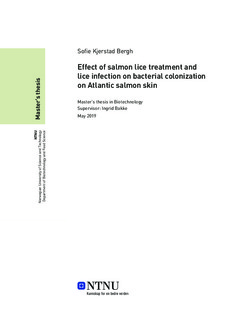| dc.contributor.advisor | Bakke, Ingrid | |
| dc.contributor.author | Bergh, Sofie Kjerstad | |
| dc.date.accessioned | 2019-10-12T14:00:55Z | |
| dc.date.available | 2019-10-12T14:00:55Z | |
| dc.date.issued | 2019 | |
| dc.identifier.uri | http://hdl.handle.net/11250/2621735 | |
| dc.description.abstract | Lakselusa er den største utfordringen lakseoppdrettsnæringen står ovenfor i Norge. I dag er det mer bevissthet og flere tiltak rundt fiskehelse og fiskevelferd, og det har blitt flere forbyggende behandling mot lakselus. Et av de forbyggende tiltakene er å tilsette komponenter i fôret som skal gjøre laksen bedre rustet til å motstå påslag av lakselus. Forebyggende tiltak er med på å heve fiskevelferden ved at det blir mindre håndtering og stressende situasjoner siden at laksen må avluses sjeldnere.
Det finnes veldig få, nærmest ingen studier på om hvordan bakteriesammensetningen i lakseskinn mucuset påvirkes av lusepåslag og behandling. I denne oppgaven ble et funksjonelt fôr testet for om det påvirker sammensetningen av skinnmikrobiotaen og mengden av bakterier i skinnmucuset, sammenlignet med et kontroll-fôr. Det ble tatt prøver av skinnslimet både før og etter påslag av lakselus, samt av vann fra hver fisketank. Sammensetningen av de mikrobielle samfunnene ble undersøkt med ved hjelp av DGGE-analyser og Illuminasekvensering av PCR-produkt som representerte de variable regionene V3 og V4 i det bakterielle 16S rRNA genet. Mengden bakterier ble estimert ved å bestemme antall kopier av 16S rDNA ved hjelp av qPCR.
Fiskeeksperimentet ble utført ved NTNU SeaLab i deres fiskelaboratorium i sammenheng med forskningsprogrammet «Taskforce Salmon Lice». Det ble ikke observert noe mindre påslag av lus med bruk av det funksjonelle fôret, 4 uker etter lusesmitte. Mengden slim ble observert å være høyere for fisk som hadde fått det funksjonelle fôret, men det var ikke en signifikant forskjell. Sammensetningen av de mikrobielle samfunnene i skinnslimet var forskjellige for fisk som hadde fått funksjonelt fôr og kontroll-fôr. I skinnslimet til fisken som hadde fått kontrollfôret var det bakterieklassen gamma-proteobakterie som hadde høyest forekomst, og slekten Oleispira skilte seg ut som typisk for kontrollgruppa og vannprøvene ved DGGE analysen. Bakterieklassen Bacilli ble funnet nesten utelukkende i skinnet til laks som hadde fått funksjonelt fôr. Slektene Streptococcus og Staphylococcus, som hører til Bacilli bidro mest til ulikhetene i skinnmikrobiotaen mellom de to fôrgruppene. Mengden av bakterier per cm2 ble også estimert, og det var et signifikant høyere antall kopier av 16S rDNA i skinnslimet til laksen som hadde fått det funksjonelle fôret. Det er tydelig at det funksjonelle fôret påvirker både sammensetning av de mikrobielle samfunnene og mengden bakterier i skinnslimet. | |
| dc.description.abstract | The biggest challenge in the salmon aquaculture industry in Norway is the salmon louse. Nowadays, there is more conscious considering fish health and fish welfare, and more preventative measures against salmon lice. One of the preventative measurements is to add a functional component in the fish feed to prevent salmon lice infection. Preventative measures contribute to less handling and stress for the salmon by the need of fewer delousing treatments.
There are few studies on how the bacterial community composition in salmon skin mucus is affected of salmon lice infestation and treatments. In this project, a functional feed was examined if it affected the composition of microbiota and the amount of bacteria in the skin mucus. Samples were collected from skin mucus before and after salmon lice infection, and from the water from the representative fish tanks. The composition of the microbial community was investigated by using DGGE analysis and Illumina sequencing of amplicons representing the variable regions V3 and V4 of the bacterial 16S rRNA gene. Amount of bacteria was estimated by determined number of copies of the 16S rDNA by using qPCR.
The fish experiment was conducted at NTNU SeaLab as a part of the research program Taskforce Salmon Lice. There were no observations of any fewer salmon lice attached to the salmon after 4 weeks post lice infection. The amount of mucus was observed to be higher for the fish fed the functional feed, but the difference was not found to be significant. In the control group, Gammaproteobacteria was most abundant in the microbial community, and the genus Oleispira was unique for the fish fed the control feed and the water samples in the DGGE-analysis. The bacterial class Bacilli was almost exclusively found in the skin mucus from fish fed the functional feed. Genera belonging to the Bacilli, Streptococcus and Staphylococcus, contributed most to the dissimilarities in the skin microbiota between the two feed groups. Amount of bacteria per cm2 was also estimated, and there was found a significant higher amount of copies of the bacterial 16S rDNA in the skin mucus from the salmon fed the functional feed. It is clear that the functional feed affected the composition of the skin mucus microbiota community and the amount of bacteria in the mucus. | |
| dc.language | eng | |
| dc.publisher | NTNU | |
| dc.title | Effect of salmon lice treatment and lice infection on bacterial colonization on Atlantic salmon skin | |
| dc.type | Master thesis | |
